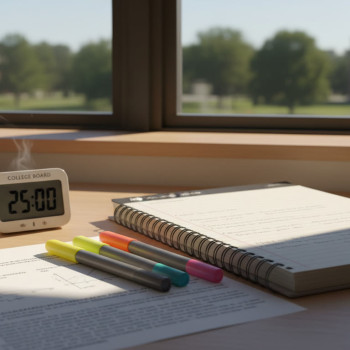Why Teacher Sign-Off Matters for AP Absences
When an AP exam date collides with a class presentation, lab, or an important school obligation, getting your teacher’s sign-off for an absence can feel like a small bureaucratic mountain. But it doesn’t have to be stressful. The reality is simple: teachers want to help students succeed, but they also need information and reassurance so they can support you fairly and keep records straight. A clear, respectful email that explains the situation and proposes a plan makes the process smooth for everyone.

Who Should Send the Email — Student or Parent?
Whenever possible, the student should send the email. It shows responsibility, maturity, and respects the teacher-student relationship. If a student is uncomfortable or the school requires parental involvement, a parent can follow up or send a parallel note. Ideally, both perspectives exist: the student’s initial email plus a parent’s confirmation when needed.
Timing: When to Reach Out
Timing is one of the biggest factors that determines whether your request is viewed sympathetically. Ask early — not at the last minute. This gives teachers time to arrange make-up work, adjust plans, or offer alternatives.
- At least 2–3 weeks before for non-emergency schedule conflicts (presentations, field trips, music recitals).
- Immediately for sudden emergencies, and follow up with documentation as soon as possible.
- During breaks or weekends is fine — teachers often check email outside school hours — but don’t expect an instant reply at midnight.
Why early email helps
Early communication communicates respect for the teacher’s time and the class schedule. It also increases the likelihood you’ll receive helpful options, like rescheduling a presentation, submitting an alternative assignment, or doing a pre-exam demonstration.
What to Include in the Email: The Essential Ingredients
A concise, well-structured email should include five elements. Think of them like a small recipe that’s easy to follow:
- Subject line that clearly states the purpose.
- Polite greeting and brief identification (your name, class, and period).
- Clear explanation of the conflict and why it matters (e.g., AP exam schedule).
- Proposed solution or plan for making up missed work.
- Offer to provide documentation and a respectful closing.
Sample subject lines
- Request: AP Exam Conflict — Make-Up Plan for Biology Presentation (May 12)
- Absence Request for AP US History Exam Day — Proposal for Makeup
- AP Exam Schedule Conflict — Seeking Guidance for Missed Classwork
Email Template: A Short, Polite, Effective Message
You can adapt the following template to fit your situation. Keep it short, factual, and solution-focused.
| Section | What to Write |
|---|---|
| Greeting & ID | Dear Ms. Rivera, my name is Jordan Miller from your AP Chemistry class (Period 3). |
| Conflict | On Thursday, May 8, I have an AP Chemistry exam scheduled by the College Board at 8:00 AM, which conflicts with the group lab presentation scheduled for that day. |
| Proposal | I would like to request permission to present earlier on Wednesday, May 7, or submit a recorded presentation with a Q&A during class. I can also complete any alternate assignment you prefer. |
| Offer of documentation | I can provide my AP admission ticket or testing schedule if needed. |
| Closing | Thank you for considering my request. I want to ensure I meet class expectations while taking the AP exam. Respectfully, Jordan Miller. |
Why this structure works
Teachers read many emails and grade lots of work. The template puts the key facts and a proposed solution up front, reducing back-and-forth and signaling accountability.
Common Situations and Tailored Approaches
Not every conflict is the same. Here are some common scenarios with suggested approaches and example language.
1. Presentation or Performance Scheduled on AP Exam Day
- Ask to present earlier or submit a high-quality recorded alternative.
- If group members are involved, coordinate the change with them first and mention their agreement in the email to the teacher.
2. Lab or Practical Exam During AP
- Offer to complete the practical exam before the AP or perform a documented alternative demonstrating the same skill set.
- Provide evidence of the AP exam date if asked.
3. Mandatory School Activity (Field Trip, Ceremony) vs AP Exam
- Explain that College Board-arranged AP exams are high-stakes and request excused absence with a make-up plan.
- Ask the school coordinator if the school has a standard policy — then cite it gently in the email if helpful.
What to Avoid: Tone and Tactics That Backfire
Certain phrases and attitudes make teachers more defensive or less willing to help. Avoid these pitfalls:
- Demanding language (“I must be excused” or “You must let me make it up”).
- Vague explanations (“I have an important test”). Be specific with dates and times.
- Last-minute notices without a plan for making up work.
- Assuming the teacher knows AP logistics — explicit clarity helps.
Documentation: What to Share and When
Teachers rarely require piles of paperwork, but offering documentation shows transparency. Useful items include:
- AP exam admission ticket or College Board confirmation email.
- Official school calendars or emails from the AP coordinator if the school manages exam scheduling.
- Notes from a parent or counselor for emergency situations.
Attach sensitive documents privately if the school’s email allows, or offer to bring them to class. Don’t share unnecessary personal details — keep documentation relevant and concise.
Sample Timeline: From First Contact to Resolution
Here’s a practical timeline you can follow to manage the entire process smoothly.
| When | Action | Why It Helps |
|---|---|---|
| 3–4 weeks before AP exams | Check the school calendar, note conflicts, and email teachers where necessary. | Early notice gives maximum flexibility. |
| 2 weeks before | Confirm any adjusted dates and submit documentation if requested. | Secures arrangements and prevents last-minute problems. |
| Exam week | Send a brief reminder (one-sentence) if needed, and keep your commitments for make-up work. | Shows follow-through and keeps communication active. |
| After exam | Complete make-up assignments promptly and thank the teacher. | Strengthens relationships and keeps grades intact. |
What Teachers Appreciate (and Why It Matters)
Teachers are more likely to approve a request when it demonstrates three qualities: responsibility, respect for the class, and a realistic plan. If you show those things, teachers often go beyond the minimum to help you succeed.
- Responsibility: You took the initiative and acted early.
- Respect: You considered the impact on classmates and class time.
- Realistic plan: You proposed a reasonable alternative and are open to compromise.
Example of an empathetic teacher reply
A helpful response might abbreviate the key points: “Yes — we can move your presentation to Wednesday during period 3; please confirm with your group. Bring the slides and be prepared for questions.” That’s an ideal outcome: fast, clear, and workable.
When School Policy Comes into Play
Some schools have formal rules for excused absences around state or national testing days. If your school has an AP coordinator or testing supervisor, loop them in after your initial teacher contact, or ask your teacher whether involving the coordinator would help. Being aware of the policy allows you to cite it calmly if necessary — but avoid weaponizing policy; lead with collaboration instead.
Handling Pushback: Respectful Negotiation Strategies
If a teacher resists your request, remain calm and solution-oriented. Try these steps:
- Ask for a short meeting in person or a quick phone call to explain the situation.
- Offer alternate solutions: extra assignment, different presentation format, or extra credit work that demonstrates learning outcomes.
- If the teacher cites curricular needs, ask how you can demonstrate mastery in a way that meets those needs.
Teachers are far more receptive to students who listen and respond constructively rather than arguing.
Sample Real-Life Case Studies
Here are two brief, anonymized examples that show the process in action.
Case Study A: The Group Presentation
Situation: Maya had an AP Statistics exam the morning of her scheduled group presentation. She emailed the teacher two weeks prior, proposed recording the presentation and joining via video for Q&A, and confirmed her group agreed. The teacher approved the recorded format and asked Maya to prepare a short live Q&A during class the day before the exam. Outcome: Maya took the AP exam and the group’s grade was preserved.
Case Study B: The Lab Practical
Situation: Omar’s AP Biology practical conflicted with the AP exam date. He met with the teacher, presented the College Board schedule, and proposed completing an equivalent lab the week before the exam outside class time. Outcome: The teacher scheduled a make-up practical during a free period; Omar provided the AP ticket as documentation and completed the lab successfully.
Practical Templates: Two Ready-to-Use Emails
Keep these short templates in your drafts folder — they save time and reduce stress when you’re juggling many tasks.
Template A — Early Request for Non-Emergency Conflict
Subject: Request — AP Exam Conflict with [Class Activity] on [Date]
Dear [Teacher Name],
My name is [Student Name], and I’m in your [Class Name, Period]. I have an AP exam scheduled by the College Board on [Exact Date] at [Time], which conflicts with the [activity]. I respectfully request permission to [proposed solution: present earlier/submit recorded presentation/complete alternative assignment] and will coordinate with my group if applicable. I can provide my AP admission ticket if you’d like documentation.
Thank you for considering this request. I appreciate your guidance on how to proceed.
Sincerely,
[Student Name]Template B — Emergency or Last-Minute Conflict
Subject: Urgent: AP Exam Conflict with [Class Activity] on [Date]
Dear [Teacher Name],
I’m writing because of an urgent conflict: I was scheduled for the AP exam on [Exact Date], but [brief statement of emergency or sudden scheduling change]. I apologize for the short notice. I propose to [proposed solution], and I can provide documentation from the testing center or AP coordinator as soon as possible. Could we arrange a brief meeting to discuss options?
Thank you for your understanding. I will follow up with any paperwork promptly.
Best,
[Student Name]Extra Help: Combining AP Prep with Coordination
While this process is mostly about communication, strong AP preparation helps too — if you feel confident about your exam timing, you’re less anxious and more organized. Personalized support can make a big difference: tutors who understand AP pacing can help build study plans that avoid last-minute conflicts. If you’re exploring options, Sparkl’s personalized tutoring offers 1-on-1 guidance, tailored study plans, and expert tutors who can help you structure revision so it doesn’t collide with school responsibilities. Their AI-driven insights can also flag potential timing conflicts early, helping you plan ahead.
Final Checklist Before Hitting Send
- Is the subject line clear and informative?
- Did you identify yourself (name, class, period)?
- Is the AP exam date and time stated exactly?
- Did you propose a realistic, specific solution?
- Did you offer documentation and a willingness to compromise?
- Is the tone respectful and concise?
Wrap-Up: Turn a Potentially Stressful Moment into a Growth Opportunity
Asking for sign-off on an AP absence is more than paperwork; it’s a chance to practice clear communication, responsibility, and collaborative problem-solving — skills that matter beyond high school. Most teachers want their students to succeed on AP exams and in class, and a well-written, timely email will get you far. Keep your note short, specific, and solution-focused. Offer documentation, show respect for the class’s needs, and follow through.

If organizing test days, scheduling makeup work, or planning study time starts to feel overwhelming, remember you don’t have to navigate it alone. Small, consistent steps — early emails, clear proposals, and if needed, personalized support like 1-on-1 tutoring — make the AP journey manageable and even empowering.
Good luck — you’ve got this. Take a breath, craft that clear email, and then focus on what truly matters: walking into the AP exam calm, prepared, and confident.



















No Comments
Leave a comment Cancel